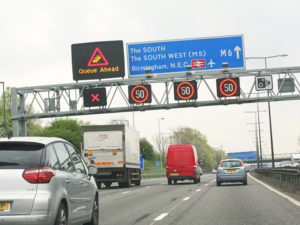Smart motorway safety tech not meeting targets, finds regulator
Technology intended to ensure safety on smart motorways is falling short of targets and must be improved “urgently”, the transport regulator has found.

The ORR said Stopped Vehicle Detection (SVD) technology was “not working as well as it should”
The Office of Rail and Road (ORR) warned that detection rates for radar-based systems used to spot stationary vehicles across ‘all lane running’ type motorways were below National Highways’ own minimum requirements.
ALR motorways – where the hard shoulder has been permanently converted to a live lane – are said to be safer than conventional motorways, but their rollout was paused in January after a Transport Select Committee called for a hold until further data was available and safety improvements had been delivered and independently evaluated.
Since then, National Highways has ensured Stopped Vehicle Detection (SVD) technology – part of a package of safety measures that the Government committed to in 2020 – has been rolled out sooner than planned but it is “not working as well as it should”, according to the ORR.
In its inaugural report, the ORR said National Highways appeared to be on course for overall safety performance on the strategic road network (SRN) in England.
But while the company has accelerated the rollout of SVD technology for ALR smart motorways, the actual performance of stopped vehicle detection is not on target. This includes false detection rates, which are substantially above the required maximum.
And the regulator says it is scrutinising the company’s progress and will take further action should it not appear to be on track to achieve the required improvements.
The ORR has also been tasked with assessing the efficacy of the 20-point Smart Motorway Action Plan put in place by Government in 2020 and says it is too early to draw firm conclusions on success yet but notes that National Highways has achieved substantial improvements in attendance times for traffic officers.
The AA said the fact that smart motorway radar tech was not working effectively was a “major concern for drivers”.
Edmund King, president, spoke out: “For ‘smart’ motorways to be truly smart and safe then the technology behind them must be fully effective. If there are doubts about the technology, then the motorways are not smart and we should revert to tried-and-tested methods.
“The radar system should be identifying 80% of stopped vehicles in a live lane and operators checking the alarms within 20 seconds. Neither of these targets have been met and it is simply unacceptable.
“As a result, vulnerable drivers have been left stranded in the most dangerous of places – the live lane of a motorway.”
Alongside a call for National Highways to urgently rectify the situation, it’s urged the Transport Secretary to run a pilot scheme which re-instates the inside lane as a hard shoulder with a Red ‘X’ and runs a national lane discipline campaign supported by the police to tackle ‘middle lane hogs’.
And it says there needs to be a rapid retrofit of emergency laybys, so no one is too far away from a place of safety.”
The RAC also called for immediate action.
Head of roads policy Nicholas Lyes said: “Breaking down in a live lane is terrifying enough but drivers must have confidence that the infrastructure is detecting them quickly so authorities can immediately close the lane. We also urge police forces to use the equipment provided to enforce ‘red X’ closed-lane signs as we think that this will reduce those flouting the law and putting drivers and roadside workers in unnecessary danger.”
But the RAC expressed doubts that any changes would ensure driver confidence with smart motorways.
“Research from the RAC shows a clear majority of drivers (70%) want to see ‘all lane running’ smart motorways scrapped in favour of schemes where a hard shoulder can be opened and closed according to how much traffic there is. As part of the Government’s review, we therefore encourage officials to explore the merits of making the dynamic hard shoulder layout the default choice for smart motorways.”
National Highways has also responded to the ORR report. Chief executive Nick Harris said: “Our roads are among the safest in the world, but every road death is a tragedy and we know there’s more we can do to further improve safety.
“The report acknowledges the good progress we have made in a number of areas, including completing most of the actions in the smart motorway stocktake action plan.
“It’s right that road users expect high performance standards, that’s why we’re committing £105m over the next two years to build further resilience into the operational technology to make journeys even safer and more reliable.”












